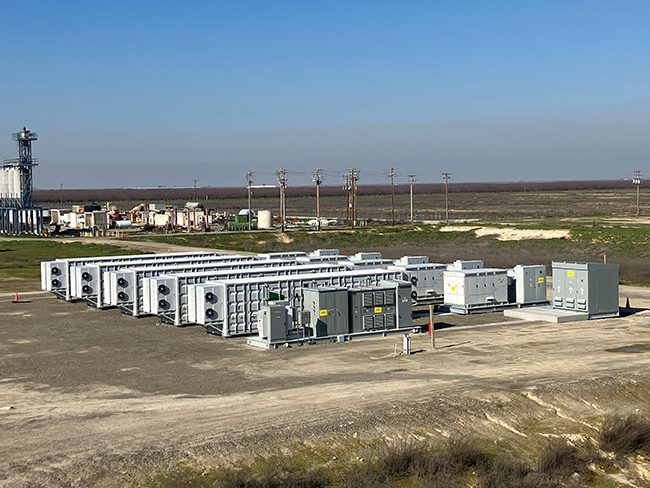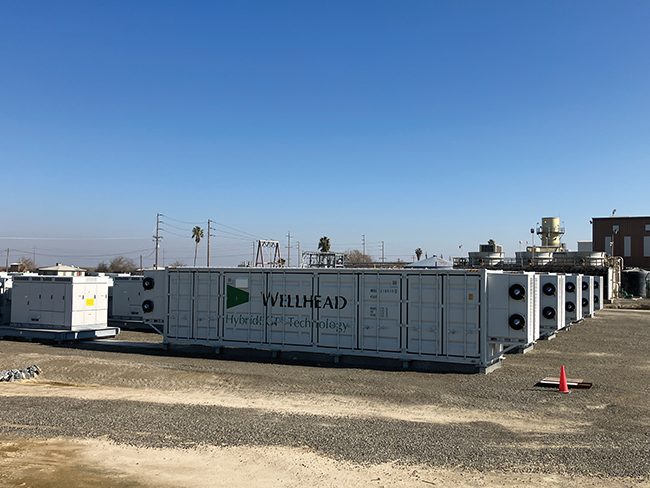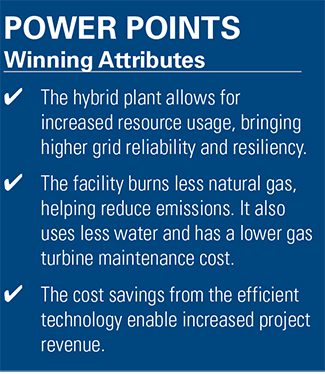Hybrid Plant Provides a Cleaner Power Solution

California is looking for additional electricity resources, while being mindful of environmental concerns. That means power companies are looking at innovative technologies to provide reliable electricity while also supporting the integration of renewable energy. The addition of energy storage to a natural gas-fired peaker plant is among the efforts.
California officials in 2004 adopted a Resource Adequacy (RA) policy framework, designed to ensure the reliability of electric service in the state. The program has two goals, according to the California Public Utilities Commission (CPUC):
- ■ To ensure the safe and reliable operation of the grid in real-time, providing sufficient resources to the California Independent System Operator (CAISO) when and where needed.
- ■ To incentivize the siting and construction of new resources needed for future grid reliability.
The CPUC program has spurred a variety of innovative power generation projects over the past two decades, highlighted by recent moves to turn existing projects into new, more efficient facilities. A project from Marin Clean Energy (MCE), which converted a natural gas-fired peaker plant into a state-of-the art energy storage hybrid, has been cited as one of California’s more interesting projects for the RA program, as it enables a fossil-fuel power facility to remain in service by adding clean energy technology.
The Fresno Hybrid, located in Fresno, adds 16 MW of battery energy storage to the existing 48-MW gas-fired plant. In the process, it enables the plant, which came online in March of this year, to burn significantly less fuel than a standard gas-fired site, and it has improved local air quality by reducing particulate emissions from the facility by as much as 78%.
 |
|
1. Wellhead’s 16-MW/16-MWh hybrid Electric Gas Turbine (EGT) battery system provides an economic pathway to speed up the energy transition while maintaining grid reliability. The EGT increases efficiency, reduces emissions, and achieves high-speed performance. Courtesy: Wellhead Power Solutions |
MCE created the hybrid project in partnership with Wellhead Power eXchange, part of Wellhead Electric Co., using Wellhead’s Hybrid Electric Gas Turbine (EGT) technology (Figure 1) that was co-developed with General Electric. The battery shortens the amount of time the natural gas plant is operating, and increases the quality of the plant’s reliability services, which support wind and solar generation. The integrated battery storage system, operated by proprietary software, provides an array of reliability benefits that neither turbines nor batteries can provide on their own.
Based on previous hybrid conversions, the project is expected to reduce greenhouse gas (GHG) emissions by up to 60% and water usage by up to 80%. During the period of April 1 to July 31, 2023, compared to the same time frame in 2002 shows the following reductions:
- ■ Starts –62%
- ■ Hours –86%
- ■ Gas –90%
This results in a direct GHG reduction of 1,806 metric tons from the same short period in 2022. In addition, there were also 114,779 MWh of spinning reserves provided by the Fresno Hybrid to the CAISO market during this period, which provides for a significant indirect reduction in GHG by allowing more efficient generation to provide energy. The project will help MCE, a community choice aggregator, combat climate change by reducing GHG emissions, create cleaner air for local residents, equitably benefit disadvantaged communities in Fresno, and support the transition to a clean energy future. Those are all reasons POWER has chosen the Fresno Hybrid as a Top Plant award winner.
Turning a Peaker Plant into a Hybrid
Grant McDaniel, director of Hybrid Engineering for Wellhead Power Solutions, a Wellhead Electric subsidiary, said his group considers the project a model for how to turn a peaker plant into an energy storage hybrid. “The Fresno Hybrid is the fourth GE LM6000 we have now modified, and while the system is complex, the process is relatively straightforward, and the hardware and software required are mature products,” McDaniel said.
Wellhead—a privately held developer and operator of innovative energy generation and energy storage facilities—designs, builds, operates, maintains, and upgrades natural gas, solar, and energy storage plants. The company specializes in providing aftermarket hybrid upgrade solutions for existing gas-fired facilities.
The company since 1982 has developed and operated more than 400 MW of power generation facilities in California and elsewhere, with ongoing development work adding to that figure. The company in 2016 designed and brought to market its Hybrid EGT solution. It has won POWER Top Plant awards previously, including in 2017 for a hybrid EGT system at two gas-fired peaker plants operated by Southern California Edison. The company also was honored by POWER in 2021 for its work at the Stanton Energy Reliability Center in California, another gas-fired peaker plant/energy storage hybrid.
Wellhead said hybrid plants such as Fresno help alleviate some of the uncertainties faced by utilities and power grid operators when it comes to net load imbalance, or the dispatchable generation required to meet load in real time, net of intermittent resources such as wind and solar. This has been a particular problem in California.
In order to meet this net imbalance, operators can either over-schedule dispatchable generation to create a surplus of power, or employ flexible, resilient resources capable of ramping up or down rapidly and dynamically to firm supplies of intermittent resources in real-time, according to Wellhead. Over-scheduling dispatchable resources, while effective to ensure power, is “inefficient both economically and environmentally,” Wellhead said. “Upgrading existing gas-fired resources with an integrated storage solution provides a more cost-effective, practical, and efficient solution to this grid-firming challenge. Thermal hybrids provide for the integrated operation of a gas-fired asset with an energy storage asset in a manner which optimizes on both high-speed performance and minimum fuel burn.”
The hybrid plant is a model of efficiency. Along with reducing GHG emissions and water use, McDaniel also noted that “Our hybrid units are currently burning 82% less gas than our non-hybrid units, with 58% less start-ups.”
Technology
The LM6000 gas turbine, according to GE, is at its heart a modified jet engine. Its quick-start capability—it can reach 50 MW in about five minutes—makes it ideal for systems supporting the intermittency of renewable energy. Adding energy storage enables the battery to kick in for the period when the wind stops blowing or clouds move in, enabling the peaker to ramp up. The battery then recharges with power from the turbine.
The gas turbine only needs to run when there’s an urgent need for electricity, while the battery system remains online. So peaker plants using the hybrid systems don’t need to run as often as they would otherwise—hence the reduced emissions, and savings of fuel and water, along with less wear and tear on equipment.
McDaniel noted, “[The] Fresno Hybrid provides primary frequency response and voltage support on a continuous basis without burning fuel unless it is required. When gas is required, it is scheduled at the minimum quantity required for the minimum time required.”
Several battery energy storage technologies are on the market, with ongoing debate about which best serves power generators and grid operators. McDaniel told POWER that while the company’s systems “are battery agnostic,” the Fresno facility features “a 16-MW/16-MWh MPINarada LFP [lithium iron phosphate] battery, packaged and integrated by RES [Renewable Energy Systems, an independent renewable energy company].”
MPINarada, based in Massachusetts, is known for battery modules that are well-suited for applications to support renewable energy. The company’s technology is used at data centers, colocation facilities, grid-edge, microgrid, commercial and industrial, utility scale, and telecom base stations.
RES, founded in 1981 and headquartered in the UK, has delivered more than 23 GW of renewable energy projects worldwide, and supports an operational asset portfolio of more than 12 GW, according to the company. It is active in 14 countries.
Community Benefits
MCE is a not-for-profit, public agency that has operated in California since 2010. It serves a 1,200-MW peak load, providing electricity service along with other programs designed to support clean energy for some 1.5 million residents and businesses in 37 communities across four counties—Contra Costa, Marin, Napa, and Solano—in the San Francisco Bay Area.
McDaniel said the Fresno project benefits the local community primarily via “lower criteria pollutants as a direct result of lower gas burn. Additionally, due to our enhanced emission reduction capability coupled with a 58% reduction in starts, there are significantly lower uncontrolled NOx emissions.”
McDaniel added: “In addition to emissions reductions, the Fresno Hybrid project repurposes yesterday’s ‘peaker’ into a grid-firming resource supporting wind and solar resources without causing curtailments as other gas-fired firming units may do. It can do this because the Fresno Hybrid has near perfect flexibility.”

The contract for 48 MW per month of firm, flexible RA capacity that MCE is purchasing extends through 2030, the company said. That RA resource is available to CAISO.
“MCE is committed to the lowest GHG footprint possible, but at this time it is still impossible to meet all the Resource Adequacy obligations without gas-fired resources,” said McDaniel, talking about the collaboration among the project’s principals. “MCE worked with Wellhead to create an RA offtake agreement that incentivized hybridization of this resource.”
Shanelle Scales-Preston, MCE board chair and mayor of Pittsburg, a city in Contra Costa County, said, “Burning fossil fuels makes people and our planet sick.” Scales-Preston, speaking when the Fresno Hybrid came online earlier this year, said, “This project fights climate change and builds healthier communities for those that need it most.”
—Darrell Proctor is a senior associate editor for POWER (@POWERmagazine).